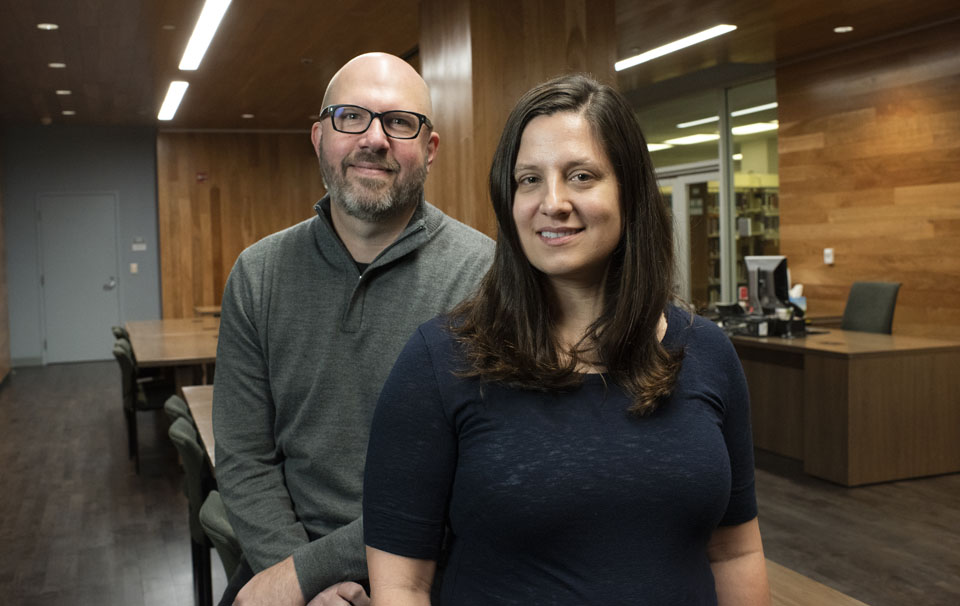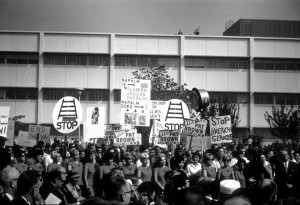CSUN Celebrates 60 Years with New Pictorial History Book

Stephen Kutay (left) and Ellen Jarosz (right) created the pictorial book, “California State University, Northridge History (Campus History),” to honor the past 60 years of the university’s history.
The first official pictorial history book on California State University, Northridge – since the early 1990s – was recently published, depicting the university’s meteoric rise and growth from its founding in 1958 to the present day.

California State University, Northridge’s public radio station, 88.5 FM, previously known as KCSN, was established on campus in the 1960s. Photo courtesy of California State University, Northridge (Campus History).
Ellen Jarosz, head of CSUN’s Special Collections and Archives, and Stephen Kutay, digital service librarian, authored the book, “California State University, Northridge (Campus History),” to showcase the university’s history over the course of the past 60 years.
Kutay and Jarosz said they wanted to bring the student experience into perspective, to represent the daily facets of the CSUN community.
“It was interesting to learn how the university came into its own. Growing quickly from a satellite of Los Angeles State College, to a university,” said Kutay. “The student body became more diverse over the years. It took this amount of time, in my opinion, to build this culture we have today. You can see this in some of the themes that get revisited over the decades.”
In 1958, CSUN was known as San Fernando Valley State College, and the college graduated just 90 students at its first commencement ceremony. Today, the university is home to about 40,000 students — one of the most diverse student populations in the country. The institution has expanded to boast bachelor’s degrees in 133 programs, 84 master’s degree options, and doctorates in educational leadership and physical therapy, according to CSUN’s Department of Admissions and Records.

CSUN has a multitude of clubs and organizations that have been the center of campus life for students since the 1960s. Photo courtesy of California State University, Northridge (Campus History).
The book starts at the birth of university’s history, “but it is not a linear history,” said Kutay. “There is a narrative represented by photographs we decided to include in it. There are themes [like student activism and community] that represent a difference in time, although it might be about the same subjects.”
Kutay and Jarosz noted that CSUN’s student and faculty engagement has been a constant force in CSUN’s culture, especially through continuous activism.
The theme of activism is represented in the book and starts to appear in the book’s section on the 1960s, when students and faculty protested for the establishment of equal opportunities for minority students. After multiple events, the university established the Africana and Chicana/o Studies departments.

CSUN’s history of activism has established diversity among students and programs on campus. Photo courtesy of California State University, Northridge (Campus History).
“People are really invested in CSUN. There’s a lot of student engagement, but also a lot of faculty engagement. This is a place the community really values,” Jarosz said. “One thing that jumped out at me was the constant of student activism in the university throughout generations.”
After being contacted by Arcadia Publishing to create the book it took Jarosz and Kutay about a year — with the help of many CSUN staff, including campus photographer Lee Choo and Mark Stover, dean of the Delmar T. Oviatt Library — to put the volume together.
“The process was like creating an exhibit in a book form. The photographs were selected to [cultivate] a long historical narrative,” Kutay said.
After careful research and curation, they laid out all of their chosen archival photographs, one by one. More than 200 images are included in the book, which, Jarosz and Kutay said, “tell the story of how students experience life at CSUN.”

Scenes from a campus protest in the 1960s. Photo courtesy of California State University, Northridge (Campus History).
The images were primarily sourced from CSUN archives, which contain thousands of images organized by topic instead of date, and made for a challenging and time-consuming process to tell a clear story.
“Each photograph required its own investigation,” Kutay said. “Research was sometimes challenging because of limitations in the number of photos and what information was recorded about them. We used multiple sources, including the campus newspaper [The Sundial] and a previously published CSUN history, ‘Suddenly a Giant,’ to gain a perspective into these images.”
For more information about “California State University, Northridge (Campus History),” visit: https://www.arcadiapublishing.com/Products/9781467129954.

 experience
experience